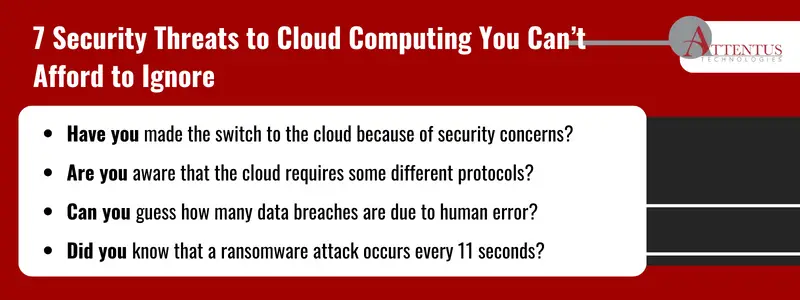Today’s hackers are increasingly sophisticated. Get the experienced help you need to stay secure.

When many businesses switch to a cloud environment from on-premises servers, security is often cited as the main reason. More robust security controls are a top benefit of cloud computing. However, that doesn’t mean you can ignore cloud computing security threats.
Think of it this way: would you leave your car unlocked in a known-to-be “safe” neighborhood? Sure, it’s less likely to get stolen there, but that doesn’t mean the risks are non-existent. Leaving your car unlocked is still ill-advised, as is lowering security measures in the “safer” cloud.
| “Moving to the cloud doesn’t mean you get to toss your old cybersecurity practices aside.
The cloud may have fewer security risks, but it also has new ones you may not have encountered before. Keep your old measures, and add a few new ones to the mix.” – Chuck Bender, CEO, Attentus Technologies |
Cloud computing requires different security protocols. Many of the standards, such as avoiding weak passwords, are still relevant, but there are a few new threats to consider.
In this article, we explore 7 threats that you should consider as you plan your cloud security strategy.
1. Data Breaches
Let’s start with the most obvious one: Keeping your data secure still needs to be your top priority. Data leaks are less likely to happen, but they can still happen. This is especially true if you’re using a massive public cloud with many nosey neighbors.
The good news is that most security standards from on-premise infrastructure remain relevant when using the cloud. Initiate and uphold robust access controls, utilize multi-factor authentication (MFA), and regularly scan your cloud resources for suspicious activity.
2. Misconfigurations
Cloud configurations differ, and even if everything was correctly set up initially, new updates may introduce new settings requiring proper configuration. Misconfigurations pose security risks, as hackers can exploit weaknesses in your settings to gain unauthorized access.
Be diligent about software updates when they appear. Don’t just click “ignore” to make the pop-up disappear – update your systems. This diligence will ensure that any of those possible weak spots stay strong. Also, ensure the people in charge of your software configurations are trained to do them correctly. One wrong setting can set you up for headaches.
3. Denial of Service (DoS Attack)
DoS (denial of service) attacks are particularly common in public cloud systems. These attacks occur when a bad actor creates a flood of network traffic to slow or stop user access. Public clouds are prime targets due to the potential to affect multiple companies simultaneously.
This is why data backups in multiple locations are still important – store copies of data across different external and internal storage devices in multiple locations. If a DoS attack slows your access to the data you need to be productive, you’ll still have it elsewhere. You can use your backup to continue working while the DoS attack is resolved.
4. Insecure API
An insecure application programming interface (API) is quite easy to exploit. Unfortunately, you have little control over them. You rely on your cloud partner to have secure APIs. Before you sign any contract for cloud services, ensure you ask about their APIs during your discovery calls.
That doesn’t mean you are helpless. Encryption can help you maintain control of API-transmitted data. No matter your provider’s security level, your data will be unusable to anyone except those with the right decryption key.
Learn More About How You Can Avoid Cloud Security Risks |
5. Unmanaged Attack Surface
Your attack surface refers to the number of possible entry points hackers could have into your system. According to Forrester, a cloud server’s attack surface is, on average, 30% larger than what business owners tend to assume pre-migration. If 30% wasn’t anticipated, 30% is likely being left unmanaged.
As you expand, your attack surface grows with every new microservice you add to your cloud environment. Your attack surface can also include small leaks that could lead to a bigger attack. For example, an attacker can use data from public Wi-Fi to figure out the names of online storage areas.
It is essential to look at the bigger picture and plan before you migrate. Consider how you will stay secure as you scale. Look for powerful yet flexible security solutions that can adapt to a fluid attack surface.
6. Human Error
Humans are the weakest link in cybersecurity. Inadvertent human error accounts for almost 90% of data loss, which costs the average U.S. company more than $15 million. Some organizations even put that number up to 95%. No amount of high-powered software can do its job right if the people behind the desk don’t use it correctly.
This highlights the importance of investing in cybersecurity training and tools. After all, computers don’t commit crimes. It’s the people who operate them who make them vulnerable to bad actors waiting in the wings to attack.
Need cybersecurity help in one of these cities? It just takes one click: |
|||
| Seattle | Tacoma | Renton | Bellevue |
7. Zero-Day Attacks
Zero-day attacks take advantage of weak spots in commonly used cloud software. The hackers behind these attacks know which weak spots often go unnoticed. Unfortunately, it’s up to the software company to manage these vulnerabilities.
For better protection against zero-day exploits in the cloud, consider using a virtual private network (VPN) to encrypt your data. You can also limit who has access to your cloud by using role-based permissions. For even more protection, you can isolate sensitive data in a separate environment.
Mitigate The Risks With a Cybersecurity and Cloud Service Provider (CSP)
These 7 precautions for these 7 risks only scratch the surface of cloud security concerns. Your business might have unique needs that don’t fit the usual mold. You need in-depth advice for full protection. And it’s not an “I’ll do it later” proposition: a ransomware attack happens every 11 seconds.
With cybercriminals becoming increasingly sophisticated, your company’s data security isn’t a do-it-yourself job. The Attentus Technologies team comprises experienced cloud consultants with the necessary expertise and a comprehensive cybersecurity package beyond basic defenses. From legal compliance and device security to 24/7 monitoring, we provide a complete solution to keep your business safe.
Reach out today to discover more about what we can do to protect your business.



